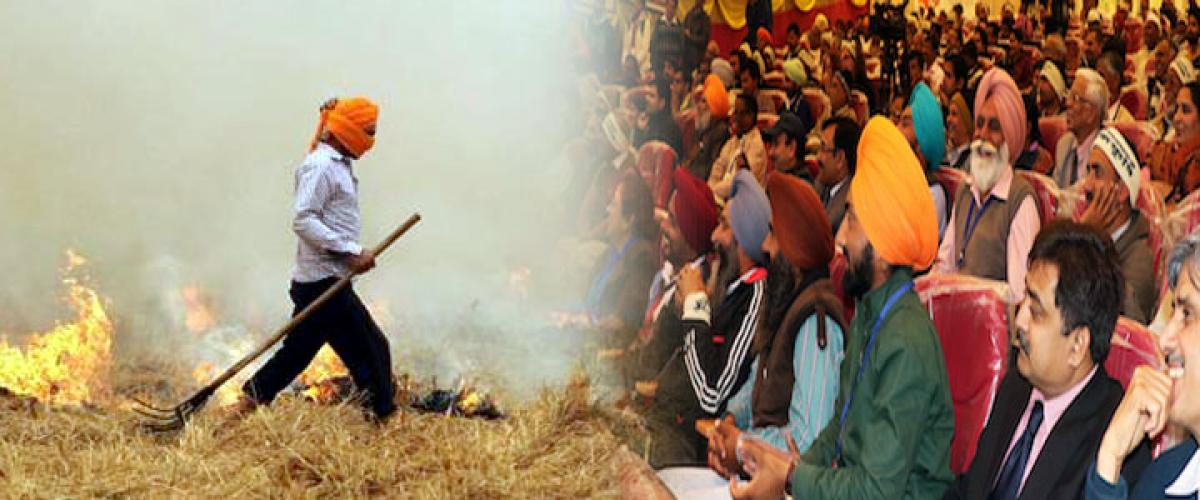Live
- SC parked Yogi’s bulldozer in garage forever: Akhilesh
- No ‘blame game’ over pollution issue: Mann
- 3 Odisha Police officers get ‘Dakshata’ award
- Punjab To Rebrand Aam Aadmi Clinics Following Central Funding Dispute
- First inscribed ‘Sati Shila’ of Odisha deciphered
- India-China Defence Ministers To Meet Following Historic LAC Disengagement Deal
- NBW against ex-BJD MP, 5 others in tribal murder case
- Combing operations on against Maoists, weapons recovered: HM
- Delhi's winter action plan: Govt to set up 250 tents for homeless individuals
- Naik reviews drinking water project
Just In

x
Highlights
As the entire northern belt of India, comprising Punjab, Haryana, Delhi and Chandigarh bear the haze-covered skies these days, farmer Tarsem Singh stands on the edge of his four-acre landholding in Punjab\'s fertile Malwa belt of Ferozepur district with a satisfied look.
Ferozepur/Chandigarh: As the entire northern belt of India, comprising Punjab, Haryana, Delhi and Chandigarh bear the haze-covered skies these days, farmer Tarsem Singh stands on the edge of his four-acre landholding in Punjab's fertile Malwa belt of Ferozepur district with a satisfied look.
 Tarsem Singh, like many other farmers, had set the paddy straw or stubble on fire overnight to get rid of the residue of the harvested paddy crop. The burnt-out field, which looks completely black with smoke simmering out at a few places, is a dark reminder of how farmers in Punjab and Haryana are year after year playing havoc with the environment and with people's lives just to save themselves a few days in sowing the next wheat and other crops.
Tarsem Singh, like many other farmers, had set the paddy straw or stubble on fire overnight to get rid of the residue of the harvested paddy crop. The burnt-out field, which looks completely black with smoke simmering out at a few places, is a dark reminder of how farmers in Punjab and Haryana are year after year playing havoc with the environment and with people's lives just to save themselves a few days in sowing the next wheat and other crops.The haze that has covered northern India up to national capital Delhi is being squarely blamed on farmers in Punjab and even neighbouring Haryana. Images released by NASA have clearly indicated that Punjab farmers have resorted to burning the paddy straw in a big way this year too, leading to the haze and other environmental and health concerns.
"What can we do? We do not have the time, resources and equipment to remove the residue from the harvested crop. Burning it is the easiest option for us to prepare our fields for the next crop early," Tarsem Singh told IANS, without any sign of remorse for what he was doing.
Like Tarsem Singh, hundreds of other farmers across Punjab are doing the same thing, worrying little about the short and long-term negative fallout of their burning the stubble.
In recent years, the Punjab government has warned the farmers, threatened them with prosecution and even offered rewards. But farmers seem to be in no mood to oblige the authorities in stopping the bi-annual exercise of burning crop residue.
"The Haryana government has warned farmers and even threatened to launch prosecution proceedings against farmers violating the ban on burning stubble. The Punjab government has announced cash rewards to districts and villages which curb the unhealthy practice," Des Raj, a farmer from Haryana's Ambala district who does not burn the crop residue, told IANS.
Haryana's environment department had earlier issued a notification to prohibit the burning of agriculture waste in open fields under the provisions of Air (Prevention & Control of Pollution) Act, 1981.
In recent years, the Haryana State Pollution Control Board has filed cases against farmers found burning their agricultural waste in the open fields.
The Punjab government, earlier this year, announced an incentive of Rs.1 crore and Rs.100,000 respectively for each district and village that are free from the crop residue burning. "We are putting up more plants for biomass gas to generate power. Hopefully in 2-3 years, when the new projects are in place, the problem of burning will be resolved," Punjab Deputy Chief Minister Sukhbir Singh Badal had said on Monday.
"Green Revolution" state Punjab contributes over 50 percent of foodgrain - wheat and paddy - to the national kitty despite having just 1.54 percent of the country's geographical area.
The Punjab Energy Development Agency (PEDA) has estimated that 15 million tonnes of paddy straw is left as residue after the crop is harvested every year (Oct-Nov). If 50 percent of this residue is harnessed, it can help generate 100 MW of power.
Agricultural scientists estimate that burning of every tonne of rice straw leads to the loss of 5.5 kg of nitrogen, 2.3 kg of phosphorus, 25 kg of potassium and 1.2 kg of sulphur. The heat from burning the residue elevates soil temperature causing the death of beneficial soil organisms like fungi, pests and reptiles that are otherwise beneficial for the crops.
Other hazards of crop burning include the fire spreading to habitation or forests, accidents caused due to poor visibility caused by the smoke and breathing problems for people.
More On

Next Story
More Stories
ADVERTISEMENT
© 2024 Hyderabad Media House Limited/The Hans India. All rights reserved. Powered by hocalwire.com







